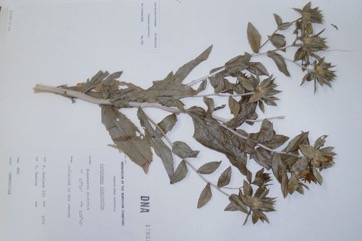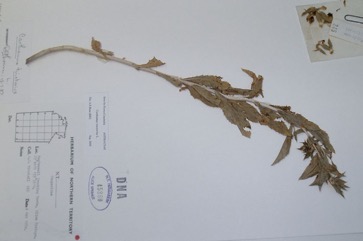Safflower

It grows in both tropical and temperate zones. It does better in drier regions. It cannot tolerate waterlogging. It does not suit the low wet tropics. It needs a good dry season for drying. It is resistant to drought. It can stand some wind and salinity. High temperatures can result in poor seed set. It does best where temperatures are 17-20°C on average. At the equator it can grow at 1600-2000 m altitude but most commonly in other regions it grows below 900 m altitude. It grows to 3,000 m altitude in Ethiopia. A pH of 5-8 is suitable. It can grow in arid places. It can grow in salty and alkaline soils. It suits hardiness zones 4-10. Tasmania Herbarium.
Also known as:
Acafroa, Cartamo, Carthame, Casubha, False saffron, Hong hua, Kardai, Kasubha, Kurdi, Kusambe, Kushumba, Kusum, Kusumbha, Kusumbo, Kusume, Kusumphul, Mexican saffron, Navadni rumenik, Sendurakam
Synonyms
- Carthamus inermis Hegi.
- Carthamus tinctorius L. var. angustifolius Wiesner
- Carthamus tinctorius L. var. inermis Schweinf.
Edible Portion
- Seeds, Leaves, Seeds - oil, Flowers, Spice, Vegetable
Where does Safflower grow?
Found in: Africa, Afghanistan, Argentina, Asia, Australia, Austria, Bangladesh, Botswana, Britain, Burkina Faso, Cambodia, Canada, Canary Island, Central America, Central Asia, Chile, China, Czech Republic, Dominican Republic, East Africa, Egypt, Ethiopia, Europe, France, Germany, Greece, Hawaii, Himalayas, India, Indochina, Indonesia, Iran, Iraq, Israel, Italy, Jamaica, Japan, Jordan, Kazakhstan, Kenya, Korea, Kuwait, Laos, Macedonia, Malaysia, Mali, Mediterranean, Mexico, Mozambique, Myanmar, Nepal, Nigeria, North Africa, North America, Pacific, Palestine, Philippines, Portugal, Romania, SE Asia, Slovakia, Slovenia, South Africa, Southern Africa, South America, Spain, Sri Lanka, Sudan, Syria, Tajikistan, Tanzania, Tasmania, Tibet, Turkey, United States, Uzbekistan, West Africa, West Indies, Yugoslavia, Zambia, Zimbabwe
Notes: There are 14 Carthamus species. They are thistle like plants. They are mostly Mediterranean.
Growing Safflower
Cultivation: Plants are grown from seed. A fine seed bed is required and seed are broadcast or drilled. It is best sown about 2-3 cm. Seeds germinate in 4-7 days and are best at 15°C. Plants should be topped as soon as the first buds appear to increase the number of flower heads. A spacing of 15-30 cm between plants is suitable. Wider spacing gives more heads per plant and closer spacing gives higher yields per area. A seeding rate of 20-30 kg per hectare is required. Crops respond to fertiliser if there is sufficient moisture. In very dry weather, harvesting in the more moist morning or evening avoids seed shattering. Plants are uprooted and heaped for a few days before threshing.
Edible Uses: The young shoots and leaves are eaten cooked or raw. They can be seasoned with soy sauce. The seeds are hulled and roasted. They are eaten as snacks. They are also used in chutneys. The seed oil is used in cooking and as a salad oil. (This can be done by boiling the seeds and floating off the oil.) The dried edible petals are used to colour foods. They can give red or yellow dyes. The slightly bitter petals can be cooked with rice.
Production: Plants take 120 days to maturity. Seeds are ripe about 35-40 days after maximum flowering. Plants are harvested when leaves turn brown.
Nutrition Info
per 100g edible portion| Edible Part | Energy (kcal) | Protein (g) | Iron (mg) | Vitamin A (ug) | Vitamin c (mg) | Zinc (mg) | % Water |
|---|---|---|---|---|---|---|---|
| Seeds | 517 | 16.18 | 4.9 | 5 | 0 | 5.5 | 5.6 |
| Leaves | - | - | - | - | - | - | |
| Flowers | - | - | - | - | - | - | |
| Seeds - oil | - | - | - | - | - | - |
Safflower Photos


References
Ambasta S.P. (Ed.), 2000, The Useful Plants of India. CSIR India. p 107
Arora, R. K., 2014, Diversity in Underutilized Plant Species - An Asia-Pacific Perspective. Bioversity International. p 112
Beckstrom-Sternberg, Stephen M., and James A. Duke. "The Foodplant Database." http://probe.nalusda.gov:8300/cgi-bin/browse/foodplantdb.(ACEDB version 4.0 - data version July 1994)
Bircher, A. G. & Bircher, W. H., 2000, Encyclopedia of Fruit Trees and Edible Flowering Plants in Egypt and the Subtropics. AUC Press. p 85
Bodkin, F., 1991, Encyclopedia Botanica. Cornstalk publishing, p 218
Brickell, C. (Ed.), 1999, The Royal Horticultural Society A-Z Encyclopedia of Garden Plants. Convent Garden Books. p 232
Brouk, B., 1975, Plants Consumed by Man. Academic Press, London. p 322
Burkill, H. M., 1985, The useful plants of west tropical Africa, Vol. 1. Kew.
Burnie, G. (Ed.), 2003, Annuals and Bulbs. The Gardener's Handbooks. Fog City Press. p 135
Cundall, P., (ed.), 2004, Gardening Australia: flora: the gardener's bible. ABC Books. p 334
Ertug, F, Yenen Bitkiler. Resimli Türkiye Florası -I- Flora of Turkey - Ethnobotany supplement
Facciola, S., 1998, Cornucopia 2: a Source Book of Edible Plants. Kampong Publications, p 35
FAO, 1988, Traditional Food Plants, FAO Food and Nutrition Paper 42. FAO Rome p 145
Hedrick, U.P., 1919, (Ed.), Sturtevant's edible plants of the world. p 164
Hemphill, I, 2002, Spice Notes. Macmillan. p 334
Hussey, B.M.J., Keighery, G.J., Cousens, R.D., Dodd, J., Lloyd, S.G., 1997, Western Weeds. A guide to the weeds of Western Australia. Plant Protection Society of Western Australia. p 92
Hu, Shiu-ying, 2005, Food Plants of China. The Chinese University Press. p 720
Jardin, C., 1970, List of Foods Used In Africa, FAO Nutrition Information Document Series No 2.p 40
Kiple, K.F. & Ornelas, K.C., (eds), 2000, The Cambridge World History of Food. CUP p 434, 1846
Knowles,P.F., 1979, Safflower, in Simmonds N.W.,(ed), Crop Plant Evolution. Longmans. London. p 31
Lazarides, M. & Hince, B., 1993, Handbook of Economic Plants of Australia, CSIRO. p 49
Li Dajue and Hans-Henning Mündel. 1996. Safflower. Carthamus tinctorius L. Promoting the conservation and use of underutilized and neglected crops. 7. Institute of Plant Genetics and Crop Plant Research, Gatersleben/International Plant Genetic Resources Institute, Rome, Italy.
Martin, F.W. & Ruberte, R.M., 1979, Edible Leaves of the Tropics. Antillian College Press, Mayaguez, Puerto Rico. p 184
Menninger, E.A., 1977, Edible Nuts of the World. Horticultural Books. Florida p 103
Molla, A., Ethiopian Plant Names. http://www.ethiopic.com/aplants.htm
Grubben, G.J.H. & El Tahir Ibrahim Mohamed, 2004. Capsicum annuum L. [Internet] Record from Protabase. Grubben, G.J.H. & Denton, O.A. (Editors). PROTA (Plant Resources of Tropical Africa), Wageningen, Netherlands. < http://database.prota.org/search.htm>. Accessed 14 October 2009.
Paczkowska, G. & Chapman, A.R., 2000, The Western Australian Flora. A Descriptive Catalogue. Western Australian Herbarium. p 158
Phon, P., 2000, Plants used in Cambodia. © Pauline Dy Phon, Phnom Penh, Cambodia. p 135
Plants for a Future database, The Field, Penpol, Lostwithiel, Cornwall, PL22 0NG, UK. http://www.scs.leeds.ac.uk/pfaf/
Polunin, O., & Stainton, A., 2006, Flowers of the Himalaya, Oxford India Paperbacks. p 211
Purseglove, J.W., 1968, Tropical Crops Dicotyledons, Longmans. p 54
READ
Royal Botanic Gardens, Kew (1999). Survey of Economic Plants for Arid and Semi-Arid Lands (SEPASAL) database. Published on the Internet; http://www.rbgkew.org.uk/ceb/sepasal/internet [Accessed 11th April 2011]
Seidemann J., 2005, World Spice Plants. Economic Usage, Botany, Taxonomy. Springer. p 86
Shah, S. K., 2014, Dietary contribution of underutilized minor crops and indigenous plants collected from uncultivated lands and forests in Nepal. in Promotion of Underutilized Indigenous Food Resources for Food Security and Nutrition in Asia and Pacific. FAO. Bangkok p 64 - leaves
Small, E., 2009, Top 100 Food Plants. The world's most important culinary crops. NRC Research Press. p 479
Solomon, C., 2001, Encyclopedia of Asian Food. New Holland. p 317
Sp. pl. 2:830. 1753
Staples, G.W. and Herbst, D.R., 2005, A tropical Garden Flora. Bishop Museum Press, Honolulu, Hawaii. p 167
Tasmanian Herbarium Vascular Plants list p 6
van Wyk, B., 2005, Food Plants of the World. An illustrated guide. Timber press. p 120
Vickery, M.L. and Vickery, B., 1979, Plant Products of Tropical Africa, Macmillan. p 33, 101
WATT
World Checklist of Useful Plant Species 2020. Royal Botanic Gardens, Kew
Yasukawa, K., Medicinal and Edible Plants as Cancer Preventive Agents. Drug Discovery Research in Pharmacognosy. p185 www.intechopen.com